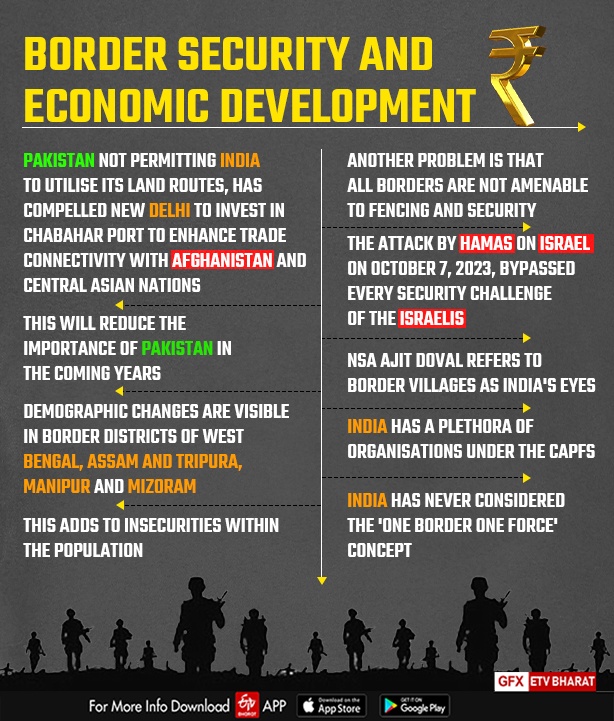Last week, speaking at the Border Security Force (BSF) investiture ceremony, India's National Security Advisor, Ajit Doval, mentioned that India's economic progress would have been faster "if we had more secure borders."
He implied that un-demarcated borders result in enhanced expenditure as these have to be manned and monitored permanently. The expenditure includes equipping and maintaining troops guarding them. A classic example is that of Europe where open borders, due to no territorial dispute between states, have resulted in lower security budgets.
Doval also hinted that disputed borders, as with Pakistan, also result in restricted trade with neighbours, which in turn impacts the economy. Opening trade with India would greatly benefit Pakistan, while India too would have access to an additional market. However, the myopic vision of the Pakistani leadership has ended up damaging their economy with minimal effect on India.
Pakistan not permitting India to utilise its land routes, has compelled New Delhi to invest in the Iranian port of Chabahar to enhance trade connectivity with Afghanistan and Central Asian nations. This will reduce the importance of Pakistan in the coming years.

Some South Asian nations also have political and economic insecurities resulting in the migration of their population into India, impacting demography. Demographic changes are visible in border districts of West Bengal, Assam and Tripura, Manipur and Mizoram. This adds to insecurities within the population.
On this Doval mentioned "border security also has a bearing on socio-economic security of the country such as the coming of radicalisation. We have large numbers of Rohingyas, as also people from the Arakan (Myanmar) area coming here. These have socio-political implications." The responsibility of blocking migration rests with the BSF along the border with Bangladesh and alongside the Assam Rifles on the border with Myanmar.
An added problem is that all borders are not amenable to fencing and security. There are riverine sectors, mountain streams as also valleys where fencing is difficult to erect, maintain and monitor. Gaps exist, which can be exploited. The only method of dominating such regions is employing technology alongside physical patrolling and monitoring. Technologically intensive equipment for surveillance involves high costs for induction as well as maintenance, however, must be resorted to.
On this, Doval stated, "If you are scattered on the ground, response capability is less, you have better quality sensors, remote sensing technology etc, you will be able to respond better." Training of personnel to exploit the equipment is equally essential. However, technology has to be backed by boots on the ground.
The attack by Hamas on Israel on October 7, 2023, bypassed every security challenge of the Israelis. The Gaza fence was considered the most sophisticated and technology-intensive border in the world. It had sensors, CCTV cameras, electrification and the like, all of which were monitored 24 by 7. These were crossed employing simple means and with total surprise resulting in mass casualties to Israelis.
Finally, most of India's border regions are remote and have remained undeveloped till now, especially in the northern sector. There was a perception that infrastructure, if developed, could be exploited by the enemy, in case of a conflict. This isolated the local population and also impacted the movement of security forces. Currently, infrastructure development is being given priority.
Development in border and remote regions will draw the populace into Indian society. It will also enable the promotion of tourism. On this Doval mentioned infrastructure development should be specific to theatres and roads, and mobile towers should be built but every theatre has got its unique challenge.
Doval referred to border villages as 'our eyes.' He linked border villages to the technology employed by Israel, mentioning, "Their cutting-edge intelligence on the border was zero. They could not distinguish that thousands of Hamas people are going to infiltrate. They had all the high technology. We are fortunate that we have so many eyes (villagers) that can monitor the border. We have got an interface with our villages."
Including villagers into the security system is part of the current 'first village' concept pushed by the Narendra Modi government. PM Modi stated after visiting Mana, "Now even for me, every village on the border is the first village in the country." These were earlier termed as "last villages."
The 'vibrant village' scheme of the Centre is intended to develop border villages in Arunachal Pradesh, Sikkim, Himachal Pradesh, Uttarakhand, Jammu and Kashmir and Ladakh. Their residents would be 'eyes and ears' for security forces. It has always been local herders who have provided early warning on enemy movements as they frequent regions not generally monitored all through.
Another interesting subject raised by Doval was jointness and interoperability amongst the CAPFs (Central Armed Police Forces). He mentioned, "Should we go ahead and think about jointness in our CAPF's interoperability? We are a huge force now together, we have also got the same type of inter-mingling duties at many places, whether it is procurement, communication, training, or standardisation." The combined strength of the CAPFs is currently approximately 10 lakh.
India has a plethora of organisations under the CAPFs. These include the BSF, Central Reserve Police Force (CRPF), Sashastra Seema Bal (SSB), Central Industrial Security Force (CISF), Assam Rifles (though it operates under the India Army) and the Indo Tibetan Border Police (ITBP). All CAPFs are under the Ministry of Home Ministry (MHA). Their numbers have been increasing steadily. While their responsibilities are generally earmarked, there is always an overlap. The Assam Rifles mans the border with Myanmar and also is employed in internal security duties in the North East, alongside the Indian Army.
The BSF is deployed along the international borders of Pakistan and Bangladesh, while a few battalions are also based on the Line Of Control (LOC). The ITBP is largely deployed in the northern theatre. The CRPF is responsible for internal security and therefore operates alongside the Indian Army in Jammu and Kashmir and North East, while the CISF secures government installations including ports and airports. The SSB is responsible for managing borders with Nepal and Bhutan. Different CAPFs operate in Left Wing Extremism areas.
India has never considered the 'one border one force' concept, implying one force is responsible for securing the border, irrespective of how many different forces are deployed. While the BSF has the responsibility of demarcated borders and the SSB of specific borders, there are no laid down responsibilities for the LOC with Pakistan and the Line of Actual Control (LAC) with China, where troops from the Indian Army, BSF and ITBP are deployed. These regions are most crucial as they remain disputed. Logically, these should be the responsibility of the Army and all additional forces placed in the region must operate under it.
However, since CAPFs are under the MHA there is a hesitation for enforcing such a concept as it would temporarily place these units under the Ministry of Defence (MoD). This adds to difficulties at the operating level as instructions flow from different controlling Headquarters, the Army and also their own.
While bringing about jointness and integration within the CAPFs would enable switching of roles and enhance functioning, there is equally a need to consider integration with the Indian Army for those deployed along the LOC and LAC for better border management. Possibly the new government could consider this aspect.



